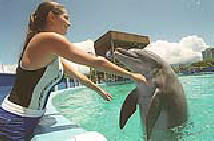|
Lab under fire after latest dolphin death
By Beverly Creamer
Staff Writer
Honolulu Advertiser
27th February 2004
An animal-rights activist group is calling for closure of the Kewalo Basin Marine Mammal Laboratory after the death Monday night of the last of three captive dolphins used for research into cognitive intelligence.
Phoenix was the second of three captive dolphins at
Kewalo Basin Marine Mammal Laboratory to die recently.
Advertiser Library photo • Aug. 15, 2000
"I would like to see the Dolphin Institute leave Hawai'i," said Cathy Goeggel, director of Animal Rights Hawai'i. "I don't want to see them having any more animals under their control. Their track record is abysmal."
Hiapo, a 20-year-old Atlantic bottlenose dolphin captured as a calf in the Gulf of Mexico, died Monday night of unknown causes. Two others have died in the past four months: Akeakamai died in November and Phoenix last month. Both were 27 and died of cancer. A dolphin's typical life span is 35 or more years.
Questions about the latest death were being referred by the laboratory to University of Hawai'i spokesman Jim Manke, who said Hiapo had a physical as recently as Feb. 19 that pronounced him in "excellent health."
The death was "kind of a mystery," Manke said, and "a surprise to everybody.” Initial tissue samples from a necropsy have shown nothing significant and samples have been sent to the Mainland for further analysis.
Manke had no information about the future of the institute or whether it would seek new animals. There have been indications during the past few years that the facility may move to Maui, and expand on land owned by the Harry & Jeanette Weinberg Foundation near Kihei.
The lab has been investigated by the U.S. Department of Agriculture, according to Manke. "Over the years they've been in and out of the lab for various reasons," he said. "Typically, if there are problems, they'll do a citation, then problems get corrected."
The facility has been under fire from animal-rights activists for more than two decades, but attention was heightened in 1977 after the unauthorized release of two dolphins by lab workers who accused the lab of dolphin mistreatment. The workers were convicted of theft.
The facility, run as a private, nonprofit foundation, was founded in 1973 by researcher and UH professor Louis Herman for studies into dolphin intelligence. It is financed chiefly through grants and contracts and has done “groundbreaking work” to show the amazing abilities of the ocean mammals.
It has also offered opportunities for students and researchers to work with dolphins. The lab has focused on studies of intelligence, including experiments on communications. One project sought a method of establishing two-way communications with the animals or an artificial language through which the animals could instruct human handlers.
The facility is tenuously connected to UH, with the university paying Herman's salary as a professor of psychology and monitoring water quality and animal care through its Institutional Animal Care and Use Committee that is part of campus research operations. The state owns the land and Herman's Dolphin Institute pays lease rent.
Goeggel said the facilities are run-down and too small for the number of dolphins that have been held there.
"We've been saying Kewalo should have been closed back in 1977 when the two original dolphins were liberated," she said. "I hold him (Herman) responsible for all of those deaths."
Herman was not available to comment.
There are new plans for the institute to participate in a $3.3 million program on Maui tracking humpback whales. The National Oceanic and Atmospheric Administration is paying for the program, which is code-named Splash.
Herman has said that two graduate students have been specially trained to take tissue samples from humpbacks as part of their tracking through the Pacific. The hope with this study is to determine to what extent humpbacks from different Pacific regions intermingle.
Reach Beverly Creamer at 525-8013 or bcreamer@honoluluadvertiser.com.
Top
|
